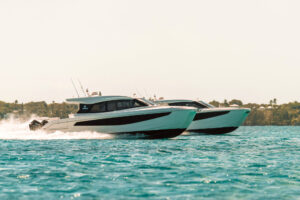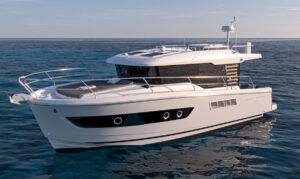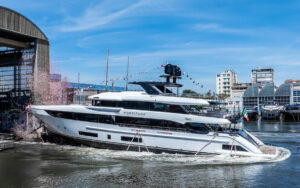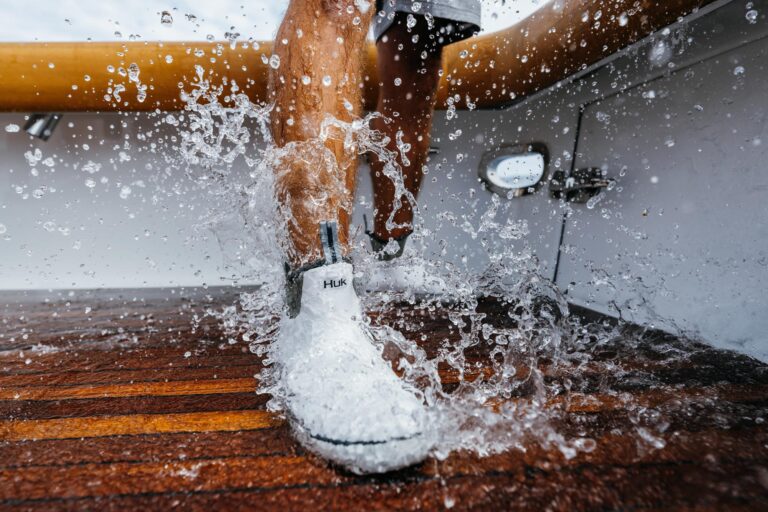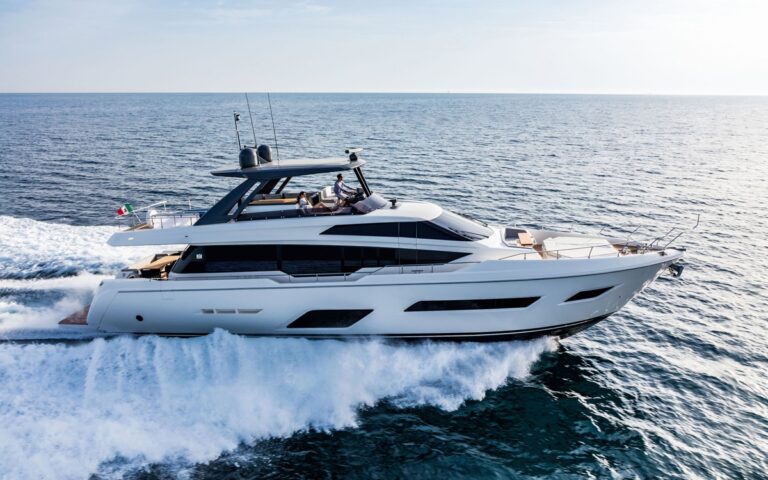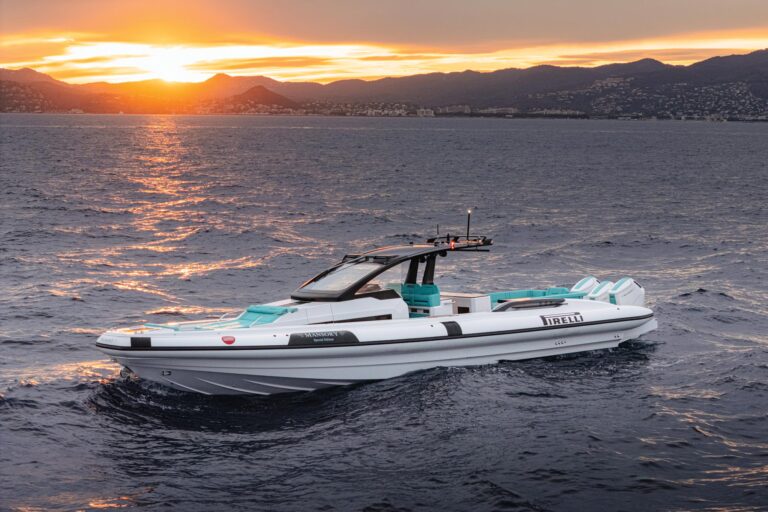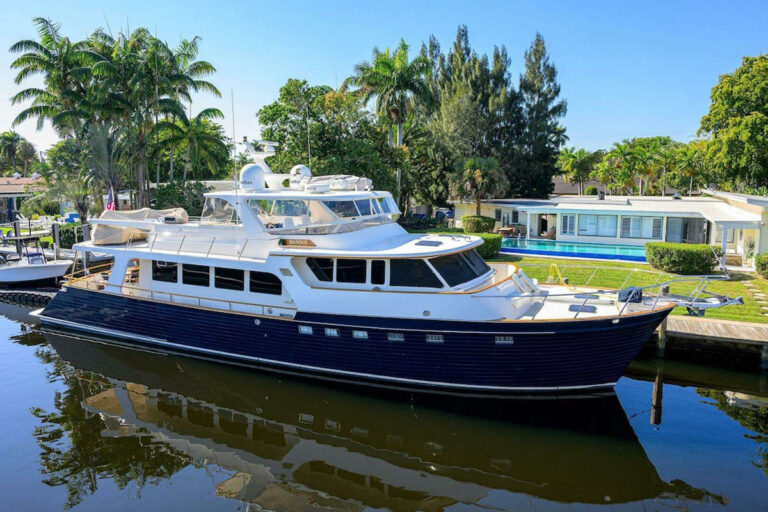Each model in Raymarine’s new C-Series, a family of standalone multifunction navigation displays, offers yachtsmen a full-function chart plotter plus control and display of information from the company’s C-Series Pathfinder radars and DSM250 black-box sonar (both optional). Available in three versions with differing screen sizes-the 61/2-inch C70, 8.4-inch C80 and 12.1-inch C120-the C-Series units are easy to install, are user friendly and provide the excellent performance and functionality of Raymarine’s traditional networked display systems at a lower cost. Since the C-Series does not require the complex installation of conventional networked units, it is an attractive match for small and large yachts alike.
Using the standard bracket mount, we temporarily secured the C120 to the cockpit table immediately forward of our boat’s helm. Chart plotters, especially those that control and display data from radar sensors, must be within easy reach of the helm, since navigation in conditions of poor visibility will demand frequent manipulation of controls. The unit’s shallow depth and the flexibility of bracket or recessed surface mounting will contribute to achieving a very workable installation. As always, when installing anything near the vessel’s steering compass, check to be sure a stray magnetic field from the new device does not disrupt the accuracy of the compass. Within a foot of our compass, the C120 presented no complications.
Chart-plotter functions and the radar and sonar sensors are controlled by 10 clearly marked single-function control buttons, five soft keys, a rotary control and a four-way track pad. Area-specific Navionics Gold cartography (compact flashcard) supplements the worldwide chart built into the system.
To be useful for real-time, real-world navigation, a chart plotter’s display must be visible in even the most adverse lighting conditions. The C120’s 800-by-600-pixel VGA-resolution TFT LCD was easy to view despite intense sunlight diffused by a white bimini (a very challenging lighting condition). Thanks to the unit’s 64-step backlighting and the day/night palette, the display was easy to read at night, too. Raymarine has done a particularly fine job of illuminating the controls. They are unlit when the screen is at full brilliance, become brighter as the screen is dimmed to the midpoint of its range, then grow dimmer as the screen’s illumination is further reduced. The message “Please replace sun cover to protect the display, which appears on the screen during the three-second shutdown cycle, is advice you should follow with all color LCDs. These elements of Raymarine’s system design indicate the care the company has taken in the design of the user interface.
A multifunction display must provide a number of data-presentation choices. Pressing the C120’s Page key for a little longer than four seconds accesses the system’s menu of page-display groups: chart, chart/sonar, chart/radar and chart/radar/sonar, plus a user-programmable set. Once you’ve chosen a page group, a momentary push of the Page key displays the page icons adjacent to the four soft keys, which are arrayed along the bottom of the screen. In “chart mode, these choices include a full-screen chart image; a split screen, with control of zoom level and scrolling for each chart image; a chart and a course-deviation indicator; and a full-screen course-deviation display, which will come in handy when you’re navigating well offshore, where charted details might be unavailable. Pages in the custom group can have up to four display windows. I like being able to set my own custom pages, and believe that, even on a screen as large as the C120’s, a page should present no more than two windows to ensure data is adequately viewable.
The greater the flexibility of a multifunction display, the greater the need to provide the user with a clear way to escape or recover from an accidentally selected operating mode. With the C120, one or two strokes of the OK or Cancel key will restore the display to the last mode you selected. It will be difficult for even a new user to get lost in the C-Series.
The radar overlay display and the MARPA (mini automatic radar plotting aid, which is built into the Pathfinder radars used with the C-Series), require a source of stable, highly responsive heading information. Heading data that can’t keep up with the boat’s maneuvering will make the overlay display and MARPA unusable. Raymarine’s gyro-stabilized Pathfinder Smart Heading System module will supply the necessary data and at the same time provide heading information to the vessel’s autopilot.
In-shore navigation often requires you to make changes in chart scale and “look ahead to off-screen areas. I was impressed by the C120’s ability to redraw the screen (less than five seconds) even when displaying chart information at the highest density. The C120’s miserly power demand, just 12 watts even when the screen is set to maximum brightness, will be particularly appreciated by sailors husbanding their battery power when under sail. In addition, less power means the unit generates less heat, prolonging its life.
The ability to perform point-and-shoot navigation-that is, use the cursor to define waypoints-is a much-appreciated virtue of a chart plotter. The C120 and its smaller but no less capable siblings make cursor-set waypoint entry easy, while allowing waypoints to be entered by latitude/longitude, range and bearing from a known point or at your boat’s present position. I find this degree of flexibility quite useful.
The unit stores up to 1,000 waypoints, plus up to 100 routes, each comprising a maximum of 50 waypoints. Waypoints are identified with one of 36 symbols and up to 16 letters and numbers. You can tack on an additional comment containing up to 16 characters. (I used this comment block in lieu of notes in the log.) You enter characters by scrolling through the alphabet with the cursor or rotary knob, but a 10-button keypad would probably be more facile. Still, the organization of the system is superb. Waypoints can be grouped, simplifying access to those related to a specific navigation task, such as entry into a given anchorage. You can also sort waypoints by name, range (closest first), symbol, date, comment and water depth. Again, losing your way in the system will be difficult indeed, which adds substantially to the chart plotter’s value.
A feature Raymarine calls SmartRoute will be a hit with anyone who has successfully sailed into an uncharted anchorage and wishes to use the information gathered during the entry to make a graceful departure. From the vessel’s recorded track, SmartRoute can create a route that can be used to guide the autopilot. This route traces the recorded track as closely as possible using a minimum number of waypoints. This capability would be most welcome when exploring, say, shallow spots in Florida’s Charlotte Harbor.
Though the C-Series has substantial internal storage for waypoints, routes and track history, some users may wish to archive their navigation data. That process is simple: Insert a card and press Data. You will be given the choice of saving data to the card or retrieving data from the card. As an alternative, the C-Series can exchange waypoint and route data with a PC or other compatible storage device using an NMEA 0183 bus.
The multiple functions of the C-Series’ control keys and the broad range of commands available for the plotter, sonar and radar sensors means it is especially important for the user to be comfortable accessing the controls for each subsystem. The C120’s excellent simulator mode and the useful spiral-bound, 15-page operating guide, printed on durable plastic designed to survive an open cockpit, should enhance the learning process. The more you know about this fine suite instruments, after all, the more pleasure you will get from using them.
Suggested base prices: C70: $1,680; C80: $2,040; C120: $2,760. Price of RayStar 120 GPS: $300; DSM250: $700. Prices of Pathfinder radars: 2kW radome: $900; 4kW radome: $1,650; 4kW open array: $3,150. Price of Smart Heading System (required for radar overlay): $700. Packages are available.
Contact: Raymarine Inc., (800) 539-5539; www.raymarine.com

